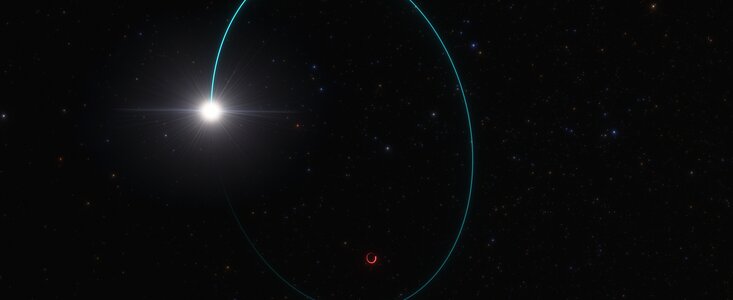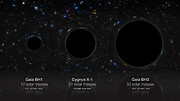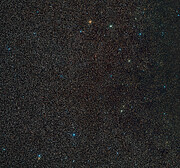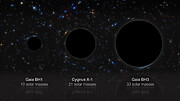Comunicato Stampa
Scoperto il buco nero stellare più massiccio della nostra galassia
16 Aprile 2024

Alcuni astronomi hanno identificato il buco nero stellare più massiccio mai scoperto nella Via Lattea, individuato nei dati della missione Gaia dell’Agenzia spaziale europea perché impone uno strano movimento “oscillante” alla stella compagna che gli orbita intorno. I dati del VLT (Very Large Telescope) dell'ESO (Osservatorio Europeo Australe) e di altri osservatori da terra sono stati utilizzati per verificare la massa del buco nero, stimandola a ben 33 volte quella del Sole.
I buchi neri stellari si formano dal collasso di stelle massicce. Quelli finora identificati nella Via Lattea sono in media circa 10 volte più massicci del Sole. Il secondo buco nero stellare per massa che si conosce nella nostra galassia, Cygnus X-1, raggiunge solo 21 masse solari, rendendo eccezionale questa nuova osservazione di un oggetto da 33 masse solari [1].
Sorprendentemente, il buco nero è anche vicinissimo a noi: a soli 2000 anni luce di distanza nella costellazione dell’Aquila, è il secondo buco nero che si conosca più vicino alla Terra. Soprannominato Gaia BH3 o semplicemente BH3, è stato trovato mentre il gruppo di lavoro di Gaia stava rivedendo le osservazioni in vista dell'imminente rilascio di dati. "Nessuno si aspettava di trovare un buco nero di massa elevata nascosto nelle vicinanze, finora non rilevato", afferma Pasquale Panuzzo, membro della collaborazione Gaia e astronomo dell'Osservatorio di Parigi, parte del Centro nazionale francese per la ricerca scientifica (CNRS). "Questo è il tipo di scoperta che si fa una sola volta nella propria carriera."
Per confermare la scoperta, la collaborazione Gaia ha utilizzato dati provenienti da osservatori da terra, incluso lo strumento UVES (Ultraviolet and Visual Echelle Spectrograph) installato sul VLT dell'ESO, nel deserto di Atacama in Cile [2]. Queste osservazioni hanno rivelato proprietà chiave della stella compagna che, insieme con i dati di Gaia, hanno permesso agli astronomi di misurare con precisione la massa di BH3.
Gli astronomi hanno trovato buchi neri altrettanto massicci al di fuori dalla nostra galassia (usando un diverso metodo di osservazione) e hanno teorizzato che potrebbero formarsi dal collasso di stelle con una composizione chimica che vede solo pochissimi elementi più pesanti dell’idrogeno e dell’elio. Si ritiene che queste stelle cosiddette "povere di metalli" perdano meno massa nel corso della propria vita e quindi mantengano una quantità maggiore di materiale per produrre un buco nero di massa elevata dopo la loro morte. Ma finora non c'erano prove che collegassero direttamente le stelle povere di metalli ai buchi neri di massa elevata.
Le stelle che vivono in coppia tendono ad avere composizioni simili, il che significa che la compagna di BH3 contiene importanti indizi sulla stella che è collassata per formare questo buco nero eccezionale. I dati di UVES hanno mostrato che la compagna è una stella molto povera di metalli, indicando che anche la stella collassata per formare BH3 dovesse essere povera di metalli, proprio come previsto.
Il risultato della ricerca guidata da Panuzzo viene pubblicato oggi su Astronomy & Astrophysics. “Abbiamo compiuto il passo eccezionale di pubblicare questo articolo sulla base di dati preliminari, prima dell’imminente rilascio dei risultati di Gaia proprio a causa della natura unica della scoperta”, afferma la coautrice Elisabetta Caffau, membro della collaborazione Gaia e scienziata dell’Osservatorio di Parigi del CNRS. Rendere disponibili i dati in anticipo consentirà ad altri astronomi di iniziare a studiare questo buco nero da subito, senza dover attendere il rilascio dei dati completi, previsto non prima della fine del 2025.
Ulteriori osservazioni di questo sistema potrebbero aver molto da dire sulla sua storia e sul buco nero stesso. Lo strumento GRAVITY installato sul VLTI (l'interferometro del VLT) dell’ESO, per esempio, potrebbe aiutare gli astronomi a scoprire se questo buco nero sta attirando materia dall’ambiente circostante e a comprendere meglio questo oggetto emozionante.
Note
[1] Questo non è il buco nero più massiccio della nostra galassia: il titolo appartiene a Sagittarius A*, il buco nero supermassiccio al centro della Via Lattea, che ha una passa pari a circa quattro milioni di volte quella del Sole. Gaia BH3 è il buco nero più massiccio finora scoperto nella Via Lattea formatosi dal collasso di una stella.
[2] Oltre a UVES sul VLT dell'ESO, lo studio si è basato su dati provenienti dallo spettrografo HERMES del telescopio Mercator gestito a La Palma (Spagna) dall'Università di Leuven (Belgio) in collaborazione con l'Osservatorio dell'Università di Ginevra (Svizzera) e dallo spettrografo ad alta precisione SOPHIE presso l'Observatoire de Haute-Provence – OSU Institut Pythéas.
Ulteriori Informazioni
Questo risultato è stato presentato nell'articolo intitolato “Discovery of a dormant 33 solar-mass black hole in pre-release Gaia astrometry” pubblicato dalla rivista Astronomy & Astrophysics (https://aanda.org/10.1051/0004-6361/202449763).
L'articolo, di P. Panuzzo et al., ha come autore la collaborazione Gaia, che include più di 300 autori da tutto il mondo, tra cui Austria, Belgio, Finlandia, Francia, Germania, Italia, Paesi Bassi, Polonia, Portogallo, Regno Unito, Repubblica Ceca, Spagna, Svezia, Svizzera, Cile e Australia.
L'ESO (European Southern Observatory o Osservatorio Europeo Australe) consente agli scienziati di tutto il mondo di scoprire i segreti dell'Universo a beneficio di tutti. Progettiamo, costruiamo e gestiamo da terra osservatori di livello mondiale - che gli astronomi utilizzano per affrontare temi interessanti e diffondere il fascino dell'astronomia - e promuoviamo la collaborazione internazionale per l'astronomia. Fondato come organizzazione intergovernativa nel 1962, oggi l'ESO è sostenuto da 16 Stati membri (Austria, Belgio, Danimarca, Francia, Finlandia, Germania, Irlanda, Italia, Paesi Bassi, Polonia, Portogallo, Regno Unito, Repubblica Ceca, Spagna, Svezia e Svizzera), insieme con il paese che ospita l'ESO, il Cile, e l'Australia come partner strategico. Il quartier generale dell'ESO e il Planetario e Centro Visite Supernova dell'ESO si trovano vicino a Monaco, in Germania, mentre il deserto cileno di Atacama, un luogo meraviglioso con condizioni uniche per osservare il cielo, ospita i nostri telescopi. L'ESO gestisce tre siti osservativi: La Silla, Paranal e Chajnantor. Sul Paranal, l’ESO gestisce il VLT (Very Large Telescope) e il VLTI (Very Large Telescope Interferometer), così come telescopi per survey come VISTA. Sempre a Paranal l'ESO ospiterà e gestirà la schiera meridionale di telescopi di CTA, il Cherenkov Telescope Array Sud, il più grande e sensibile osservatorio di raggi gamma del mondo. Insieme con partner internazionali, l’ESO gestisce APEX e ALMA a Chajnantor, due strutture che osservano il cielo nella banda millimetrica e submillimetrica. A Cerro Armazones, vicino a Paranal, stiamo costruendo "il più grande occhio del mondo rivolto al cielo" - l'ELT (Extremely Large Telescope, che significa Telescopio Estremamente Grande) dell'ESO. Dai nostri uffici di Santiago, in Cile, sosteniamo le operazioni nel paese e collaboriamo con i nostri partner e la società cileni.
La traduzione dall'inglese dei comunicati stampa dell'ESO è un servizio dalla Rete di Divulgazione Scientifica dell'ESO (ESON: ESO Science Outreach Network) composta da ricercatori e divulgatori scientifici da tutti gli Stati Membri dell'ESO e altri paesi. Il nodo italiano della rete ESON è gestito da Anna Wolter.
Links
- Articolo scientifico
- Fotografie del VLT
- Notize dell'ESA sulla ricerca
- Per i giornalisti: iscrivetevi per ricevere i nostri comunicati sotto embargo nella vostra lingua
- Per i ricercatori: avete una storia da raccontare? Inviateci il vostro articolo scientifico
Contatti
Pasquale Panuzzo
Observatoire de Paris - PSL/CNRS
Paris, France
Tel.: +33 1 45 07 78 42
E-mail: pasquale.panuzzo@observatoiredeparis.psl.eu
Elisabetta Caffau
Observatoire de Paris - PSL/CNRS
Paris, France
Tel.: +33 1 45 07 78 73
E-mail: elisabetta.caffau@observatoiredeparis.psl.eu
Bárbara Ferreira
ESO Media Manager
Garching bei München, Germany
Tel.: +49 89 3200 6670
Cell.: +49 151 241 664 00
E-mail: press@eso.org
Anna Wolter (press contact Italia)
Rete di divulgazione scientifica dell'ESO
e INAF-Osservatorio Astronomico di Brera
Milano, Italy
Tel.: +39 02 72320321
E-mail: eson-italy@eso.org
Sul Comunicato Stampa
| Comunicato Stampa N": | eso2408it |
| Nome: | Gaia BH3 |
| Tipo: | Milky Way : Star : Evolutionary Stage : Black Hole |
| Facility: | Very Large Telescope |
| Instruments: | UVES |
| Science data: | 2024A&A...686L...2G |
Our use of Cookies
We use cookies that are essential for accessing our websites and using our services. We also use cookies to analyse, measure and improve our websites’ performance, to enable content sharing via social media and to display media content hosted on third-party platforms.
ESO Cookies Policy
The European Organisation for Astronomical Research in the Southern Hemisphere (ESO) is the pre-eminent intergovernmental science and technology organisation in astronomy. It carries out an ambitious programme focused on the design, construction and operation of powerful ground-based observing facilities for astronomy.
This Cookies Policy is intended to provide clarity by outlining the cookies used on the ESO public websites, their functions, the options you have for controlling them, and the ways you can contact us for additional details.
What are cookies?
Cookies are small pieces of data stored on your device by websites you visit. They serve various purposes, such as remembering login credentials and preferences and enhance your browsing experience.
Categories of cookies we use
Essential cookies (always active): These cookies are strictly necessary for the proper functioning of our website. Without these cookies, the website cannot operate correctly, and certain services, such as logging in or accessing secure areas, may not be available; because they are essential for the website’s operation, they cannot be disabled.
Functional Cookies: These cookies enhance your browsing experience by enabling additional features and personalization, such as remembering your preferences and settings. While not strictly necessary for the website to function, they improve usability and convenience; these cookies are only placed if you provide your consent.
Analytics cookies: These cookies collect information about how visitors interact with our website, such as which pages are visited most often and how users navigate the site. This data helps us improve website performance, optimize content, and enhance the user experience; these cookies are only placed if you provide your consent. We use the following analytics cookies.
Matomo Cookies:
This website uses Matomo (formerly Piwik), an open source software which enables the statistical analysis of website visits. Matomo uses cookies (text files) which are saved on your computer and which allow us to analyze how you use our website. The website user information generated by the cookies will only be saved on the servers of our IT Department. We use this information to analyze www.eso.org visits and to prepare reports on website activities. These data will not be disclosed to third parties.
On behalf of ESO, Matomo will use this information for the purpose of evaluating your use of the website, compiling reports on website activity and providing other services relating to website activity and internet usage.
Matomo cookies settings:
Additional Third-party cookies on ESO websites: some of our pages display content from external providers, e.g. YouTube.
Such third-party services are outside of ESO control and may, at any time, change their terms of service, use of cookies, etc.
YouTube: Some videos on the ESO website are embedded from ESO’s official YouTube channel. We have enabled YouTube’s privacy-enhanced mode, meaning that no cookies are set unless the user actively clicks on the video to play it. Additionally, in this mode, YouTube does not store any personally identifiable cookie data for embedded video playbacks. For more details, please refer to YouTube’s embedding videos information page.
Cookies can also be classified based on the following elements.
Regarding the domain, there are:
- First-party cookies, set by the website you are currently visiting. They are stored by the same domain that you are browsing and are used to enhance your experience on that site;
- Third-party cookies, set by a domain other than the one you are currently visiting.
As for their duration, cookies can be:
- Browser-session cookies, which are deleted when the user closes the browser;
- Stored cookies, which stay on the user's device for a predetermined period of time.
How to manage cookies
Cookie settings: You can modify your cookie choices for the ESO webpages at any time by clicking on the link Cookie settings at the bottom of any page.
In your browser: If you wish to delete cookies or instruct your browser to delete or block cookies by default, please visit the help pages of your browser:
Please be aware that if you delete or decline cookies, certain functionalities of our website may be not be available and your browsing experience may be affected.
You can set most browsers to prevent any cookies being placed on your device, but you may then have to manually adjust some preferences every time you visit a site/page. And some services and functionalities may not work properly at all (e.g. profile logging-in, shop check out).
Updates to the ESO Cookies Policy
The ESO Cookies Policy may be subject to future updates, which will be made available on this page.
Additional information
For any queries related to cookies, please contact: pdprATesoDOTorg.
As ESO public webpages are managed by our Department of Communication, your questions will be dealt with the support of the said Department.







